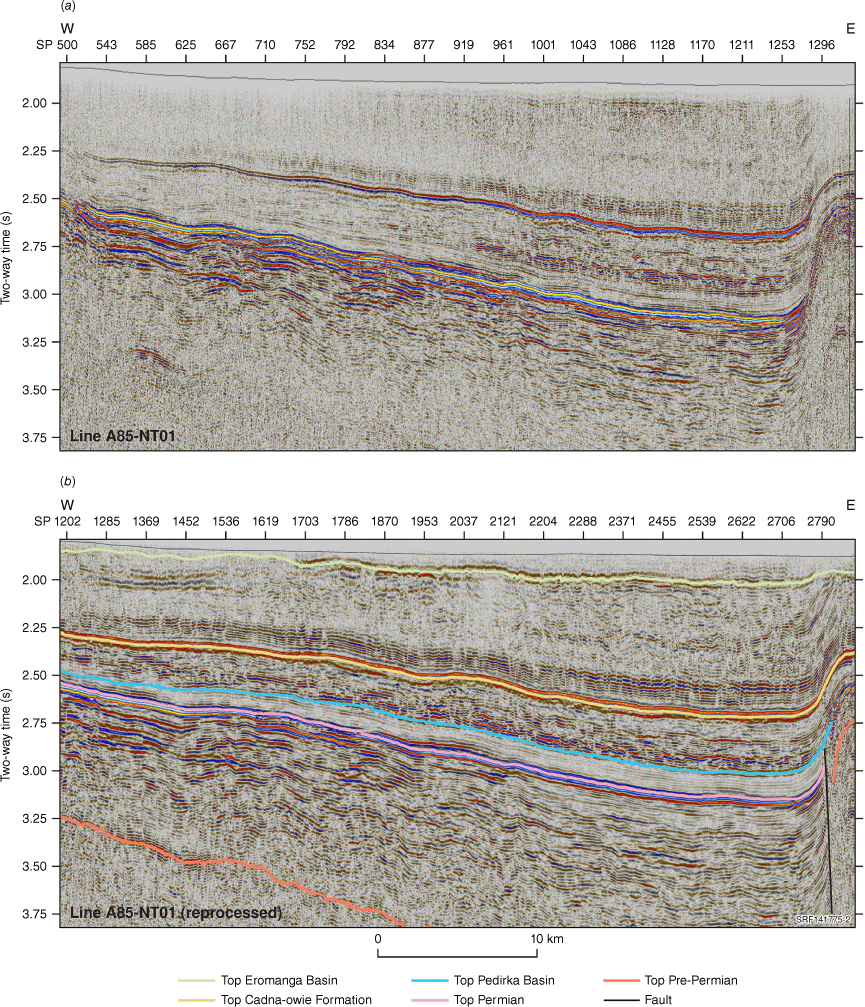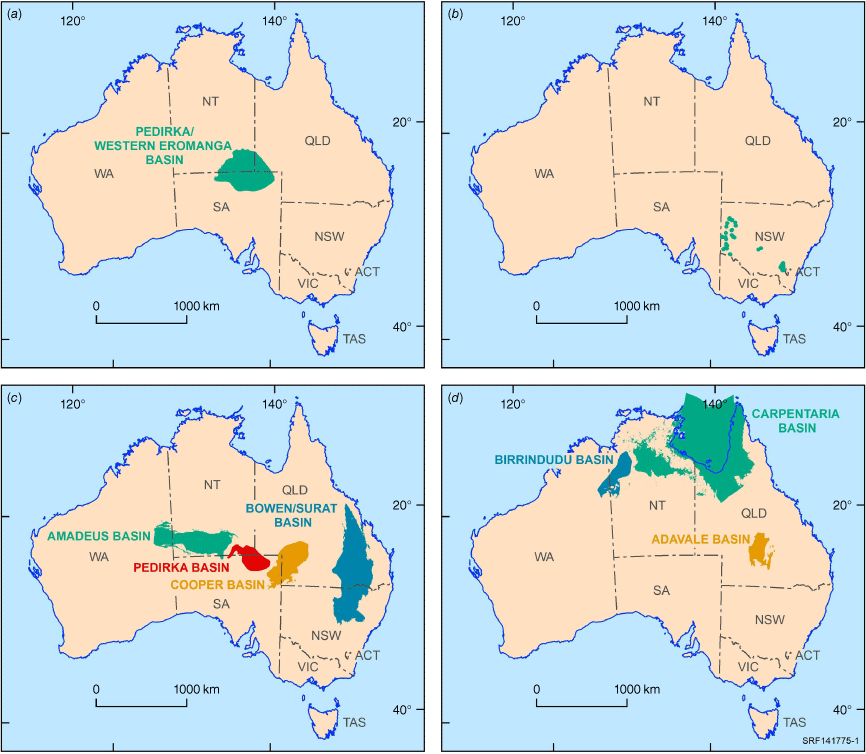Australia’s Future Energy Resources project: the untapped potential of onshore low carbon energy resources
Thomas Bernecker A * , Barry Bradshaw A , Jeremy Iwanec A , Keith Bradey A , Ryan Owens A , Andrew Feitz A , Aleksandra Kalinowski A and Lidena Carr AA

Thomas (Tom) Bernecker is a Geoscientist who holds an MSc from the University of Aachen (RWTH), Germany and a PhD from Melbourne’s La Trobe University. His early geological work involved the development of models for siliciclastic and carbonate depositional systems in NW Europe and in Australia. After a lectureship at the University of Melbourne, Tom joined the Victorian Department of Natural Resources and Energy where his work was focussed on the hydrocarbon prospectivity of the Gippsland and Otway basins. Tom joined Geoscience Australia in 2007 and is currently the Director of Energy Resources Advice and Promotion. Member: PESA, SEAPEX, SEPM. |

Barry Bradshaw is a Geoscientist with over 30 years of experience undertaking geological and geophysical studies and play-based prospectivity studies for conventional and unconventional hydrocarbon resources, geological storage projects, and sediment-hosted mineral deposits. Barry is currently employed as the Energy Resources and Advice activity leader at Geoscience Australia, and has previously worked as a Principal Geologist at CGSS consultants, Senior Research Scientist at AGSO/Geoscience Australia and Research Scientist at Texas A&M University (USA). Barry graduated from the University of Sydney in 1988, and completed a PhD in Earth Sciences at the University of Waikato (New Zealand) in 1991. |

Jeremy Iwanec is a Geoscientist with 20 years of petroleum industry experience. Jeremy completed a BSc (Honours) in Applied Geology from the University of New South Wales in 2002, before joining Oil Search Limited in 2003. At Oil Search, he worked on various projects across Papua New Guinea, Yemen and Kurdistan, undertaking play-based exploration studies, 2D and 3D seismic interpretation, structural and stratigraphic modelling, well planning and delivery, and resource assessments. In 2021, Jeremy joined Geoscience Australia as an Energy Resources Geoscientist where he is currently conducting studies of sediment-hosted energy resources. |

Keith Bradey is a Geoscientist with over 35 years of experience in oil and gas exploration. He graduated from the University of Sydney with a Bachelor of Science degree in 1984, and then completed a post graduate Diploma of Geoscience from Macquarie University in 1989. During his career, Keith has been involved in seismic acquisition and processing at Geophysical Service Inc. (GSI), as well as various exploration activities at Oil Search Limited. Keith now works in the Energy Resources and Advice team at Geoscience Australia. |

Ryan Owens is a Geoscientist in the Energy Resources and Advice team at Geoscience Australia. He graduated from Australian National University in 2007 with a BSc in Geology (Hons). Subsequently he worked in mineral exploration before undertaking further studies in Paleoceanography at the Research School of Earth Sciences, ANU. Ryan joined Geoscience Australia in 2014 through the graduate program and has contributed to a variety of projects including the northern Houtman Sub-basin prospectivity study, the Geological and Bioregional Assessments of the Beetaloo and Cooper basins and the annual Acreage Release. Member: PESA, GSA. |

Andrew Feitz is an Environmental Engineer and Director of Low Carbon Geoscience and Advice at Geoscience Australia. He holds a PhD from the University of New South Wales (UNSW) and worked as a Senior Researcher at UNSW and the Karlsruhe Institute of Technology (Germany). Andrew leads Geoscience Australia’s efforts in supporting the implementation of the National Hydrogen Strategy. |

Aleksandra Kalinowski is Assistant Director of Low Carbon Geoscience and Advice at Geoscience Australia and holds an undergraduate degree in Geology from the Australian National University and a PhD from the University of New South Wales. Aleks has worked on carbon capture, utilisation and storage over the past 20 years and continues to focus on research, advice and education around CCUS and other decarbonisation opportunities and low-emission energy resources. |

Lidena Carr is a Geoscientist for the Onshore Energy Systems Directorate, Basins Systems Branch, Minerals, Energy and Groundwater Division, GA. She graduated from the ANU with a BA/BSc (Hons) in 2004, majoring in Geology and Human Ecology. In 2007, she joined GA with the then ACRES (satellite imagery), before moving to her current position as a Seismic Interpreter and Basin Analyst. She currently works within the EFTF. |
Abstract
The ‘Australia’s Future Energy Resources’ (AFER) project, funded under the Government’s ‘Exploring for the Future’ (EFTF) program has been completed. The project’s four modules have evaluated a mixture of energy resource commodities, including natural gas, hydrogen, subsurface storage opportunities for carbon dioxide and hydrogen. They are complemented by several targeted basin inventories which outline the current geological knowledge of energy resources in underexplored, data-poor regions. Several publicly available data sets have been generated and published under the AFER project, including 3750 line-km of reprocessed 2D seismic data, acquired in the Pedirka and western Eromanga basins, of which key lines have been interpreted and integrated with geological and petrophysical well log data. Relative prospectivity maps have been produced for five energy resource commodities from 14 play intervals to show the qualitative variability in prospectivity of these resources, including quantitative resource assessments where warranted. Results from the AFER project have helped to identify and geologically characterise the required energy resource commodities to accelerate Australia’s path to net zero emissions.
Keywords: carbon capture utilisation and storage, common risk segment maps, economic fairways, energy resources, hydrogen, Pedirka Basin, residual oil zones, resource assessments, salt accumulations, western Eromanga Basin.
Introduction
The ‘Australia’s Future Energy Resources’ (AFER) project has been a 4-year multidisciplinary undertaking that investigates the potential of energy resource commodities in selected onshore sedimentary basins. In the context of Australia’s path towards a low-carbon economy, the project has focussed on energy resources that will support this transition, including natural gas and hydrogen.
The AFER project comprises four modules: (1) energy resources assessment, (2) hydrogen studies, (3) suitability of residual oil zones (ROZs) for carbon capture utilisation and storage (CCUS), (4) basin inventories. This abstract focusses on the workflow and results of Module 1, while key results of Modules 2–4 are only briefly summarised, as their details feature in separate publications (including in the Australian Energy Producers Journal). For further information on the AFER project and a comprehensive listing of available products and publications visit https://www.eftf.ga.gov.au/australias-future-energy-resources.
The project’s areas of interest are shown in Fig. 1. Area selection was determined by the need to improve the understanding of potentially prospective energy resources in basins where such resources are known to occur but have remained underexplored. The Pedirka and western Eromanga basins region was selected for the energy resource assessment (Module 1) because of their proximity to the hydrocarbon producing Cooper and Amadeus basins. Hydrogen studies (Module 2) investigated the occurrence of salt accumulations across onshore Australia for hydrogen storage purposes and carried out soil sampling for the detection of natural hydrogen seeps. The CCUS component (Module 3) reviewed the presence of ROZs from which liquid hydrocarbons could be produced via carbon dioxide (CO2) injection, representing a potential CO2 storage opportunity. The Basin Inventory work (Module 4) addresses the current status of geological and resource related knowledge about selected underexplored onshore basins.
Resource assessment methodologies
Four energy resource commodities were assessed for their prospectivity, including conventional hydrocarbons, coal seam gas (CSG), other unconventional hydrocarbon resources, and the suitability of subsurface sediments for CO2 storage. A major component of the resource assessment was to reprocess 3750 line-km of legacy seismic data, which has provided an impressive uplift in the structural and stratigraphic resolution (Fig. 2). Regional seismic interpretations have provided new insights into the tectonostratigraphic evolution of the basins and were used to produce depth-structure and isochore maps to support the energy resource assessments (Geoscience Australia 2022).
Example of seismic reprocessing results represented by a section across the Dalhousie-McDills Ridge. (a) Original legacy seismic line; (b) reprocessed and interpreted seismic line, showing marked uplift allowing the subsurface mapping of sequence stratigraphic surfaces to support resource assessments.

In cooperation with the Northern Territory Geological Survey and South Australia’s Department of Energy and Mines, the stratigraphic framework for the Pedirka and western Eromanga basins (Fig. 3) was reviewed, defining five Permo-Triassic and nine Jurassic to Cretaceous play intervals (Bradshaw et al. 2022). The GIS-Pax™ Player software was used to assess conventional hydrocarbons within each play interval and was modified for assessments of unconventional hydrocarbons (CSG, shale resources, tight sand resources) and CO2 geological storage potential. Post-drill analyses of 42 wells (Iwanec et al. 2023) were carried out and coupled with the mapping of gross-depositional environments, petrophysical analysis of wireline log data to constrain net shale and sand thickness, effective porosities and relative permeabilities, to construct common risk segment (CRS) maps for each of the four energy resource commodities within the 14 play intervals. These CRS maps form the foundation of the project’s qualitative energy resource commodity assessments.
Chronostratigraphic chart for the Pedirka and western Eromanga basins showing the 14 play intervals and the relative prospectivity of each play to contain sediment-hosted energy resources (Geologic Time Scale after Gradstein et al. 2020).

Resource assessment results
On a regional scale, the assessment results show a wide range in relative prospectivity for the different energy resource commodities in the Pedirka and western Eromanga region (Fig. 3).
Conventional hydrocarbons
Previous exploration highlighted the Poolowanna and Madigan troughs as the most prospective areas with respect to conventional hydrocarbons. This is directly supported by small oil and gas flows at Poolowanna 1 and is further supported by residual oil zones and gas indications in several wells. An operating petroleum system has charged the Peera Peera and Poolowanna play intervals, and possibly the Namur-Murta play interval.
CSG resources
Outcomes from the play-based assessment indicate that the prospectivity for CSG is marginal at best and confined to the upper and lower Purni play intervals. This is primarily due to areas where thick continuous coal seams are known to occur over the Eringa and Madigan troughs are undersaturated in gas due to either groundwater flushing, and/or degassing of coal seams during regional uplift events. Farther east over the Poolowanna Trough, coal seams are too thin and discontinuous to be prospective for CSG resources.
Other unconventional hydrocarbons
Other potentially prospective unconventional hydrocarbons are limited to oil-prone tight sandstones in the Peera Peera and Poolowanna play intervals across the Poolowanna Trough. Shale-hosted hydrocarbons may also occur in fluviolacustrine sediments from the Peera Peera and Poolowanna play intervals across the same area, but prospectivity is downgraded by the thin and discontinuous nature of these shales limiting their producibility.
Geological storage of CO2
The AFER project placed a strong focus on assessment of the project area’s geological storage potential utilising migration assisted storage in saline aquifers. Four risk elements, injectivity, storage effectiveness, containment and structural complexity, were evaluated. The resulting prospectivity maps highlight that the central and eastern parts of the western Eromanga Basin area offer the best storage potential within the Jurassic and Lower Cretaceous play intervals (Fig. 3) with the Namur-Murta play interval offering the highest potential. Structural complexity and storage effectiveness are the risk elements with the lowest chance of success in the most prospective fairways. Relatively low prospectivities for carbon dioxide storage are evident in the underlying Permian and Triassic play intervals because of the low reservoir permeabilities and localised nature of sealing units.
Key results from AFER modules 2–4
Hydrogen studies
Molecular hydrogen (H2) is almost ubiquitous in natural gases in Australia, but its concentration is generally minor with about 80% of gases analysed at Geoscience Australia having H2 <0.01 mol%. Nevertheless, there are historical occurrences of H2-rich gases (i.e. >10 mol% H2) in all states and the Northern Territory (Boreham et al. 2021) that provide the impetus for future H2 exploration. New H2-rich gas occurrences have been identified in traditional sedimentary basins but also associated with old mineralised cratonic rocks. Extending the H2 studies from depth to the near surface, soil gas surveys for H2 (and helium) have recently been completed across central and western New South Wales (Fig. 1b) in collaboration between Geoscience Australia and the Geological Survey of NSW.
Australia has thick rock salt accumulations that appear suitable for underground hydrogen storage. This includes the Boree Salt in the Adavale Basin, the Chandler Salt in the Amadeus Basin and the Kilroo Salt in the offshore Polda Basin. The Canning Basin contains significant quantities of rock salt but much of it is present as thin interbeds, unsuitable for cavern construction. There is potential for higher purity salt diapirs in the basin, however, and these should be the target for future salt caverns. Other prospective regions include the Officer Basin and offshore Bonaparte Basin.
Assessing ROZs for geological storage of CO2
Our geological and petrophysical assessment of oil fields in the Cooper-Eromanga, Bowen-Surat, Amadeus and Pedirka basins suggest that ROZs are present in some of these regions, and particularly in the Cooper-Eromanga basins. Further investigations indicate that CO2 storage efficiencies can be gained as a result of CO2–oil interactions, which change the density and viscosity of the CO2 and impact CO2 plume sweep efficiency and lateral flow (Kalinowski et al. 2024).
The cost of CCS projects on a national basis was modelled in collaboration with Monash University. The resulting ‘Economic fairways for CO2 storage’ model has been converted into a publicly accessible online tool accessed through Geoscience Australia’s new CCUS portal (https://portal.ga.gov.au/persona/ausccus). The model considers transport distance and cost, as well as the injection and storage properties of storage reservoirs for a range of injection rates (Walsh et al. 2023).
Basin inventories
The inventories contain whole-of-basin summaries regarding the petroleum geology, petroleum systems, hydrocarbon prospectivity, exploration history and status, data availability and quality, critical risks and exploration uncertainties for both conventional and unconventional hydrocarbons. The most recent work focussed on the Adavale (Korsch et al. 2023), Carpentaria (McCabe 2023) and Birrindudu basins (Korsch 2024) highlighting the known basin resources for each basin. Additional work building on the Adavale Basin inventory includes burial and thermal history modelling as well as petroleum systems modelling (Palu et al. 2023).
Summary and conclusion
The AFER project is a multidisciplinary undertaking that investigated the potential of those energy resource commodities the development of which will contribute to Australia’s efforts of reaching net zero emissions by 2050. Play-based assessments indicate good resource potential for conventional hydrocarbons in the Pedirka-western Eromanga region, including feasible areas for the storage of carbon dioxide. Hydrogen studies have highlighted widespread occurrences of salt accumulations in Australia which may be accessed for future hydrogen storage. Regional geological descriptions of selected underexplored basins flag new opportunities for energy resource exploration.
Assessing the geological potential of low carbon energy commodity resources is becoming increasingly relevant. The workflow applied by the AFER project has yielded robust, well-founded results that are applicable to underexplored regions and can be adjusted for the assessment of energy resources other than hydrocarbons.
Data availability
The data that support this study are available from the Exploring for the Future, Data and products webpage at http://www.eftf.ga.gov.au/data-products.
Acknowledgements
The authors acknowledge the thorough review of the manuscript by Chris Nicholson and Diane Jorgensen. Travis Ashe and Chris Evenden are thanked for figure preparation. This abstract is published with the permission of the CEO, Geoscience Australia.
References
Boreham CJ, Edwards DS, Czado K, Rollet N, Wang L, van der Wielen S, Champion D, Blewett R, Feitz A, Henson PA (2021) Hydrogen in Australian natural gas: occurrences, sources and resources. The APPEA Journal 61, 163-191.
| Crossref | Google Scholar |
Bradshaw BE, Rollet N, Iwanec J, Bernecker T (2022) A regional chronostratigraphic framework for play-based resource assessments in the Eromanga Basin. The APPEA Journal 62, S392-S399.
| Crossref | Google Scholar |
Geoscience Australia (2022) Pedirka-Simpson Basin 2D Reprocessed Seismic Data Package 2021–2022. Available at https://pid.geoscience.gov.au/dataset/ga/146309
Iwanec J, Strong P, Bernecker T (2023) Underexplored but not forgotten: assessing the energy resources potential of the greater Pedirka Basin region through play-based mapping. The APPEA Journal 63, S251-S256.
| Crossref | Google Scholar |
Kalinowski A, Tenthorey E, Clennell MB, Seyyedi M, Kempton R, Patterson C, Jackson S (2024) The potential for CO2 storage in residual oil zones in onshore Australian basins. Australian Energy Producers Journal 64, S154-S159.
| Crossref | Google Scholar |
Korsch R (2024) ‘Basin Inventory Birrindudu Basin’. Record 2024/55. (Geoscience Australia: Canberra) 10.26186/148672
Korsch R, Carr L, Palu T (2023) ‘Basin Inventory Adavale Basin’. Record: 2023/010. (Geoscience Australia: Canberra) 10.26186/147864
McCabe PJ (2023) ‘Basin Inventory Carpentaria Basin’. Record 2023/51. (Geoscience Australia: Canberra) 10.26186/148830
Palu T, Korsch R, Edwards D, Khider K, Boreham C, MacFarlane S, Bailey A (2023) ‘Petroleum systems modelling of the Adavale Basin 1D burial and thermal history modelling’. Record 2023/11. (Geoscience Australia: Canberra) 10.26186/147706
Walsh SDC, Kalinowski A, Patterson C, Tenthorey E, Haynes M (2023) ‘Evaluating the economic potential for carbon sequestration projects’. (Geoscience Australia: Canberra) 10.26186/147915
 Thomas (Tom) Bernecker is a Geoscientist who holds an MSc from the University of Aachen (RWTH), Germany and a PhD from Melbourne’s La Trobe University. His early geological work involved the development of models for siliciclastic and carbonate depositional systems in NW Europe and in Australia. After a lectureship at the University of Melbourne, Tom joined the Victorian Department of Natural Resources and Energy where his work was focussed on the hydrocarbon prospectivity of the Gippsland and Otway basins. Tom joined Geoscience Australia in 2007 and is currently the Director of Energy Resources Advice and Promotion. Member: PESA, SEAPEX, SEPM. |
 Barry Bradshaw is a Geoscientist with over 30 years of experience undertaking geological and geophysical studies and play-based prospectivity studies for conventional and unconventional hydrocarbon resources, geological storage projects, and sediment-hosted mineral deposits. Barry is currently employed as the Energy Resources and Advice activity leader at Geoscience Australia, and has previously worked as a Principal Geologist at CGSS consultants, Senior Research Scientist at AGSO/Geoscience Australia and Research Scientist at Texas A&M University (USA). Barry graduated from the University of Sydney in 1988, and completed a PhD in Earth Sciences at the University of Waikato (New Zealand) in 1991. |
 Jeremy Iwanec is a Geoscientist with 20 years of petroleum industry experience. Jeremy completed a BSc (Honours) in Applied Geology from the University of New South Wales in 2002, before joining Oil Search Limited in 2003. At Oil Search, he worked on various projects across Papua New Guinea, Yemen and Kurdistan, undertaking play-based exploration studies, 2D and 3D seismic interpretation, structural and stratigraphic modelling, well planning and delivery, and resource assessments. In 2021, Jeremy joined Geoscience Australia as an Energy Resources Geoscientist where he is currently conducting studies of sediment-hosted energy resources. |
 Keith Bradey is a Geoscientist with over 35 years of experience in oil and gas exploration. He graduated from the University of Sydney with a Bachelor of Science degree in 1984, and then completed a post graduate Diploma of Geoscience from Macquarie University in 1989. During his career, Keith has been involved in seismic acquisition and processing at Geophysical Service Inc. (GSI), as well as various exploration activities at Oil Search Limited. Keith now works in the Energy Resources and Advice team at Geoscience Australia. |
 Ryan Owens is a Geoscientist in the Energy Resources and Advice team at Geoscience Australia. He graduated from Australian National University in 2007 with a BSc in Geology (Hons). Subsequently he worked in mineral exploration before undertaking further studies in Paleoceanography at the Research School of Earth Sciences, ANU. Ryan joined Geoscience Australia in 2014 through the graduate program and has contributed to a variety of projects including the northern Houtman Sub-basin prospectivity study, the Geological and Bioregional Assessments of the Beetaloo and Cooper basins and the annual Acreage Release. Member: PESA, GSA. |
 Andrew Feitz is an Environmental Engineer and Director of Low Carbon Geoscience and Advice at Geoscience Australia. He holds a PhD from the University of New South Wales (UNSW) and worked as a Senior Researcher at UNSW and the Karlsruhe Institute of Technology (Germany). Andrew leads Geoscience Australia’s efforts in supporting the implementation of the National Hydrogen Strategy. |
 Aleksandra Kalinowski is Assistant Director of Low Carbon Geoscience and Advice at Geoscience Australia and holds an undergraduate degree in Geology from the Australian National University and a PhD from the University of New South Wales. Aleks has worked on carbon capture, utilisation and storage over the past 20 years and continues to focus on research, advice and education around CCUS and other decarbonisation opportunities and low-emission energy resources. |
 Lidena Carr is a Geoscientist for the Onshore Energy Systems Directorate, Basins Systems Branch, Minerals, Energy and Groundwater Division, GA. She graduated from the ANU with a BA/BSc (Hons) in 2004, majoring in Geology and Human Ecology. In 2007, she joined GA with the then ACRES (satellite imagery), before moving to her current position as a Seismic Interpreter and Basin Analyst. She currently works within the EFTF. |



